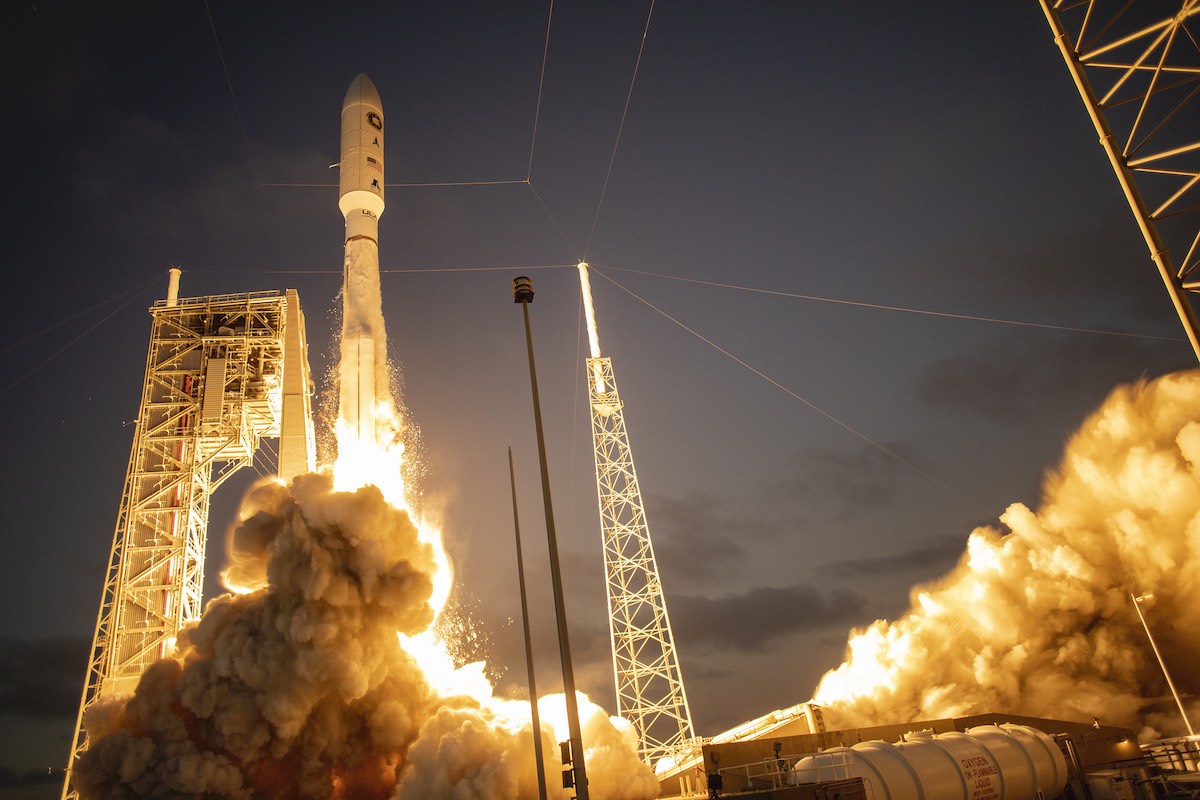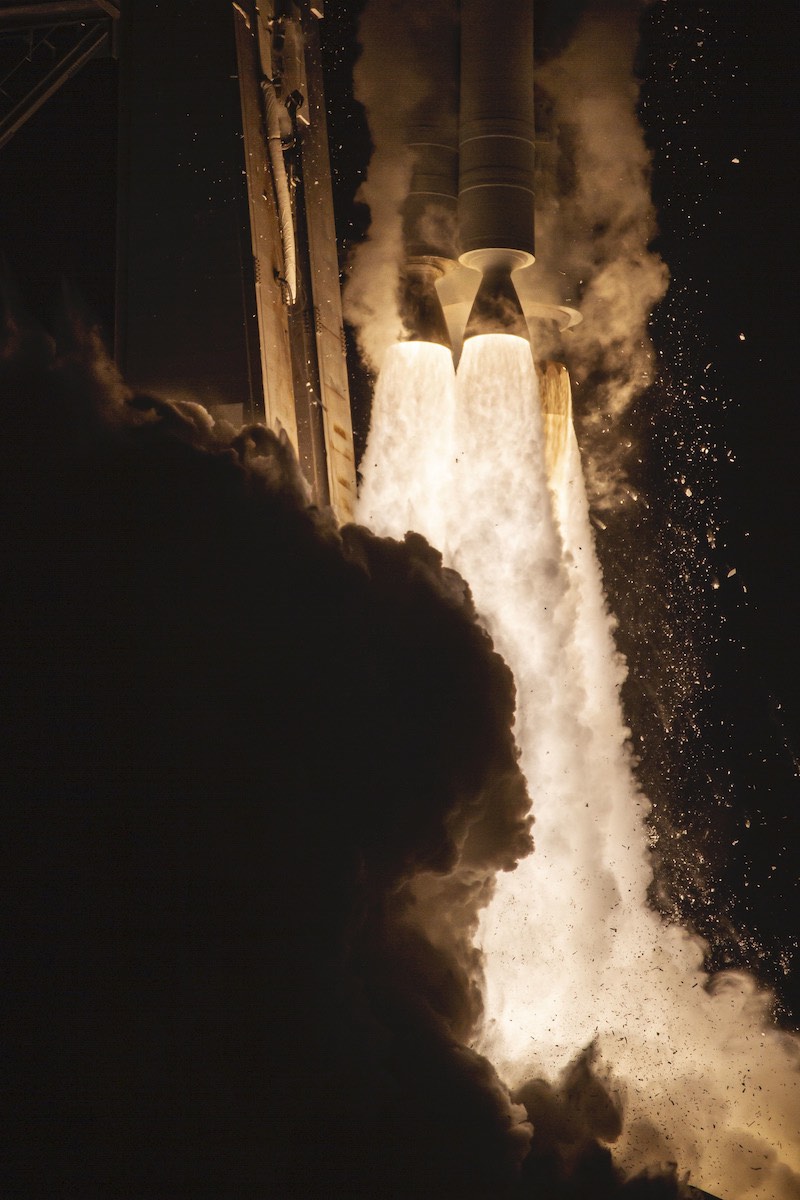
A top secret cargo for the U.S. government’s spy satellite agency soared into orbit from Cape Canaveral at the tip of a United Launch Alliance Atlas 5 rocket Friday night, successfully debuting a new solid-fueled booster design that ULA says are cheaper and easier to handle than previous strap-on motors.
The new booster design, produced by Northrop Grumman and named the GEM 63, replaces the AJ-60A solid rocket boosters from Aerojet Rocketdyne that powered previous Atlas 5 missions.
The three GEM 63 boosters and a kerosene-fueled Russian-made RD-180 engine produced nearly 1.8 million pounds of thrust to propel the 206-foot-tall (63-meter) Atlas 5 off the launch pad at Cape Canaveral at 5:32 p.m. EST (2232 GMT) Friday.
A little more than three hours later, ULA and the National Reconnaissance Office — which owns the payload launched on top of the Atlas 5 rocket — released press statements declaring the mission a success.
The Atlas 5 mission was delayed several times from an original launch attempt planned Nov. 3.
ULA rolled the Atlas 5 rocket back to its hangar to replace an environmental control system duct feeding conditioned air to the payload on top of the launcher, setting up for a countdown Nov. 4 that was later scrubbed due to a problem with valves in the ground liquid oxygen system at launch pad 41.
Once teams resolved the valve issue, ULA decided to return the rocket to its vertical hangar again for protection against bad weather from Tropical Storm Eta. The Atlas 5 rolled out to pad 41 again Thursday afternoon in preparation for Friday’s launch opportunity.
A couple of minor technical concerns delayed the launch 19 minutes into Friday evening’s window, but ULA cleared the issues and the launch team voiced approval to proceed with the terminal countdown as the sun set on Florida’s Space Coast.
The Atlas 5’s RD-180 main engine roared to life at T-minus 2.7 seconds, followed moments later by ignition of the three GEM 63 strap-on boosters. After darting through low clouds, the launcher arced toward the northeast and climbed into light from the setting sun illuminated the rocket’s smoke plume in orange.
The three solid-fueled boosters burned out and jettisoned from the rocket nearly two minutes into the flight, with the spent motor casings clearly visible as they tumbled in Atlas 5’s wake. The rocket’s Swiss-made payload fairing dropped away after the three minute-point of the mission, revealing the NRO’s classified payload after the Atlas 5 reached the uppermost layers of the atmosphere.
At that point, the mission entered a government-ordered news blackout, citing the sensitive nature of the national security payload. ULA’s live broadcast ended, and the rest of the mission occurred in secret. The Atlas 5’s Centaur upper stage was expected to take over for multiple firings of its Aerojet Rocketdyne RL10 engine before deploying the NRO payload in orbit.
The NRO issued a press release at 8:44 p.m. EDT (0144 GMT) to confirm a successful conclusion to the launch, known as NROL-101.

“The successful launch of NROL-101 is another example of the NRO’s commitment to constantly evolving our crucial national security systems to support our defense and intelligence partners,” said U.S. Space Force Col. Chad Davis, director of the NRO’s Office of Space Launch.
“2020 has been an especially challenging year for the launch and space community given the COVID-19 pandemic,” Davis said in a statement. “I’m continually impressed by our partners and our NRO team members on their ability to find new and innovative ways to collaborate in this environment and ensure we are meeting our mission requirements while prioritizing the safety, security and health of our entire launch team.”
The NRO revealed no information about the payload flying on the NROL-101 mission, but warning notices released to pilots and mariners before the launch suggested the Atlas 5 rocket would head on a northeasterly track from Cape Canaveral, following a path parallel to the U.S. East Coast before flying near the Canadian maritime provinces.
The trajectory indicated the Atlas 5 would release the NRO payload into a high-inclination orbit.
The NRO owns data relay satellites and several spacecraft designed to intercept communications signals in elliptical Molniya-type orbits that stretch nearly 25,000 miles (40,000 kilometers) above Earth at their highest points. Those orbits are tilted around 63 degrees to the equator, giving satellites regular views of Russia and other parts of the northern hemisphere.
The Atlas 5 launch Friday night was likely aiming for a similar Molniya-type orbit, according to multiple independent experts who track spy satellite activity.
Ted Molczan, a leader in the global community of hobbyists who expertly monitor satellite movements, wrote in the online SeeSat-L forum that he believes the payload on the NROL-101 mission is likely a new spacecraft for the NRO’s fleet of Satellite Data System orbiting communications stations.
The SDS, or Quasar, satellites relay images from the NRO’s sharp-eyed optical and radar surveillance satellites to analysts, allowing users to more quickly receive imagery than if they had to wait for the spy satellites to fly over a ground station.
SDS satellites fly in Molniya orbit and in geosynchronous orbit more than 22,000 miles (nearly 36,000 kilometers) over the equator. The last two SDS satellites launched into a Molniya orbit took off in 2004 and 2007, meaning it’s about time for a replacement to join the fleet, according to Molczan.
The NRO launched new signals intelligence satellites into Molniya orbits in 2014 and 2017. “This year seems too soon for a replacement or new generation,” Molczan wrote.
The signals intelligence satellites have launched into Molniya orbits more often from Vandenberg Air Force Base in California, while SDS satellites have launched from Cape Canaveral, according to Molczan.
“Data collected by NRO’s national security systems is used to provide intelligence to senior policy makers, the Intelligence Community and Department of Defense, as well as U.S. allied partners,” the NRO said in a statement. “Additionally, information collected by NRO systems can be used to assist emergency and disaster relief efforts in the U.S. and around the world.”
The NROL-101 mission was ULA’s 30th launch for the National Reconnaissance Office.
“Thank you to our mission partners, the NRO and the United States Space Force for their continued confidence and partnership with ULA,” said Gary Wentz, ULA vice president of government and commercial programs. “This launch was the inaugural launch of our new GEM 63 solid rocket motors, an instrumental step for ULA to build flight experience in preparation for the Vulcan Centaur, our next generation launch vehicle.”

The new GEM 63 motors that debuted on the Atlas 5 launch Friday night measured 66 feet (20 meters) long and 63 inches (1.6 meters) wide. The GEM 63 motors can produce 373,800 pounds of thrust at maximum power.
They are designed to ignite on the launch pad and burn for 94 seconds, consuming 97,500 pounds (44.2 metric tons) of pre-packed solid propellant before jettisoning to fall into the sea.
The GEM 63 booster design is an evolution of the 60-inch GEM 60 motor built by Northrop Grumman for ULA’s Delta 4 rocket family. There are no more Delta 4s left to fly that require the GEM 60 solid rocket booster.
Northrop Grumman, through its predecessors ATK and Orbital ATK, also supplied smaller strap-on boosters for the now-retired Delta 2 and Delta 3 rocket families.
The boosters give an extra push to rockets carrying heavier payloads into orbit, or missions that need to place satellites into high-altitude orbits. The Atlas 5 rocket can launch with any number of solid-fueled boosters between zero and five, depending on the requirements of each mission.
Like the AJ-60A motor that flew on previous Atlas 5s, the GEM 63 motor has fixed nozzles and a curved, or ogive, nose cone, providing the proper aerodynamic shape to ensure the booster cleanly falls away from the Atlas 5 after burnout. Northrop Grumman’s GEM 63 booster produces roughly the same thrust and has approximately the same dimensions as the AJ-60A, allowing ULA to introduce the new booster model as a “direct replacement” for the older Aerojet Rocketdyne version.
Aerojet Rocketdyne’s AJ-60A motor has a flawless record since its first use on the Atlas 5’s third launch in July 2003, with 127 of the boosters flown to date.
ULA announced in 2015 the selection of Orbital ATK — now part of Northrop Grumman — to provide solid rocket boosters for future Atlas 5 launches, and for the next-generation Vulcan Centaur rocket. At the time, ULA said the selection of the GEM 63 rocket motor would “significantly lower the price to ULA and to the U.S. government.”
The Northrop Grumman boosters, made with the help of advanced robotics and automation, are also designed to be easier to attach to the launch vehicle at the Vertical Integration Facility, the company says.
A lengthened version of the GEM 63 known as the GEM 63XL will fly on ULA’s new Vulcan Centaur rocket, which is scheduled for an inaugural launch in the second half of 2021. The Atlas 5 rocket can fly with any number of solid rocket boosters from zero to five, while the Vulcan Centaur can launch in configurations with two, four or six boosters alongside the rocket’s two Blue Origin BE-4 main engines.
Northrop Grumman performed three test-firings of GEM 63 boosters at a test site in Promontory, Utah, before engineers cleared the solid-fueled rocket motor for flight.
The AJ-60A motors from Aerojet Rocketdyne are not done yet.
Julie Arnold, a ULA spokesperson, said earlier this year the company will fly the Aerojet Rocketdyne boosters on future Atlas 5 missions until the rocket is fully transitioned to the Northrop Grumman motors. The AJ-60As will continue launching on missions with Boeing’s Starliner commercial crew capsule, and ULA is working with NASA toward the future use of GEM 63s on astronaut launches.
Arnold said ULA plans for all Atlas 5 launches after 2021 to use the new GEM 63s.
ULA’s next mission will be the launch of another classified NRO spy satellite payload on a Delta 4-Heavy rocket from Cape Canaveral. That mission, designated NROL-44, was supposed to take off in August but a series of launch pad problems have kept the Delta 4-Heavy on the ground.
Email the author.
Follow Stephen Clark on Twitter: @StephenClark1.



